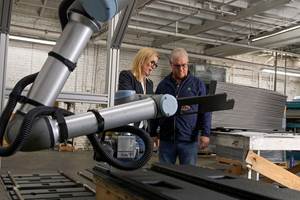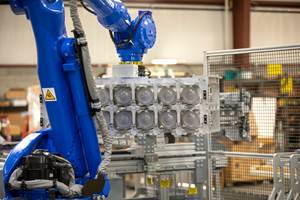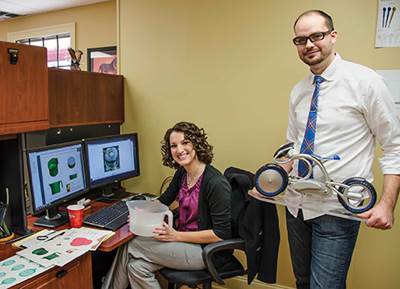Fast, Easy Six-Axis Robot Integration Created by a Molder for Molders
Custom injection molder Noble Plastics has done its own six-axis robot integration with several brands of injection machines for over 20 years. Now it’s offering a turnkey service with what’s said to be unmatched speed, affordability and ease of implementation.

Noble Plastics is now offering turnkey systems with a robot; basic, intuitive operator interface; online configurator; programming for the initial job; and integration with the injection machine. Options include EOAT design, future job programming, hard guarding, and training in EOAT design and robot programming. (Photos: Noble Plastics)
Scott Rogers knows what it’s like to try to wring profits out of a small custom injection molding business spanning a wide range of applications from customers that often need engineering assistance to get their parts up and running. He’s technical director of Noble Plastics, which he and his wife Missy Rogers (company president) launched in 2000 in Grand Coteau, La. Today, they operate 19 injection presses of five different brands in sizes from 35 to 940 tons.
For Scott and his staff, few tools are more critical to profitability and efficiency than automation, which is why Noble Plastics has Fanuc six-axis robots on all its injection machines. The integration was performed inhouse with the philosophy that, as Rogers puts it, “The robot should be a partner for the operator, not a hindrance.” After 20-plus years of robot integration experience and eight years as an authorized integrator for Fanuc robots, Noble Plastics is now launching a turnkey package of a robot, basic and intuitive user interface, end-of-arm tooling (EOAT)—if desired, integration with the injection machine controls, job-specific programming and operator training. “We can do all this faster and at lower cost than your average integrator,” Rogers says, “and the end result is easier for the operator to use.”
A Problem-Solving Approach
This robot integration program is designed to serve molders with needs similar to Noble’s:
• Reduce labor requirements;
• Increase value added;
• Implement automation without needing to appreciably change operator training beyond that required to run a molding machine;
• Quick implementation;
• Improve operational flexibility;
• Implement a standard automation philosophy across different brands and ages of injection presses;
• Implement automation at the press that is compatible with upstream automation (e.g., insert inspection) and downstream automation (e.g., palletizing).
Noble’s answer, in short, is to “provide a base machine-tending system that is cost-effective, quick to install, requires little knowledge to operate and can be configures for additional products with new EOAT and basic path programming.” This requires standard hardware configurations, standard machine interface connections, basic program architecture, a human-machine interface (HMI) and connectivity to send and receive information to and from intelligent systems (e.g., IQMS/DelmiaWorks, RJG).
‘The question is how much value can you add between the time you grab the part and let it go.’
Rogers has always believed that the most capable and flexible automation for a custom molder of a wide variety of parts is a six-axis robot (his favorite being Fanuc). “The question is how much value can you add between the time you grab the part and let it go.” In his view, a six-axis robot wins that contest hands down over Cartesian types—even those with a servo wrist that provides five total axes of motion. A six-axis robot can also do things a human cannot do—or at least not easily, such as separate parts from a 16-cavity tool by cavity, segregating good parts, rejects and sprues into different containers, with good/bad part data determined by the injection machine’s QC parameters, process-monitoring systems like RJG or integrated inspection systems.
Historically, one of the limitations of six-axis robots has been high integration costs, since applications have largely been custom integrations driven by a specific product requirement and engineered from the ground up. That leads to the second historical limitation: long lead times. And, Rogers, notes, the expertise required to repurpose six-axis articulated robots for new jobs has been significantly higher than for simpler Cartesian systems. “More capability translates into more options, which means more decisions required by the programmer. For example, a three-axis Cartesian robot has exactly one configuration in which it can position a mounted gripper around a sprue. A six-axis robot has an infinity of options. Determining the best solution requires judgment, and thus experience or training, not required on the simpler system. All these factors make designing a standard operator interface more difficult.”
Systems can be delivered in as little as 2 to 4 weeks and commissioned in 1 to 2 days, vs. up to 4 to 6 months.
That led Noble to design what Rogers calls “basic machine-tending interface software that is relatively simple to program for most situations while maintaining the full functionality of the industrial robot platform when the application requires it.” He sees this as suited to cycle times of 20 sec or more, which are common in U.S. custom molding, other than for consumer packaging. The standard package can be integrated with any press equipped with a Euromap 12 or 67 interface; otherwise, custom programming is required. The system provides such basic functions as cell initialization with self-diagnostics, part picking/placing, sprue picking/placing, reject placing, quality sample drop (scheduled and on request), alarm reporting, interface for data collection and ERP systems such as IQMS/DelmiaWorks, and E-stop recovery or automatic restart after short operator interruptions.
Systems reportedly can be delivered in as little as two to four weeks and commissioned in one to two days, whereas custom systems can take four to six months. Options include EOAT design services and training for customers who wish to design their own robot tooling. Each system is delivered with programming for a specific application. Continued support for installed systems includes the option to reprogram the robot for subsequent jobs—typically in one to four hours—or Noble can train users to do it themselves. Safety fencing for the robot is also available.
Noble Plastics’ new online configurator includes suggestions to help the user choose the size of the robot and mounting on the floor or machine platen.
Noble has also just launched an online configurator (immtend.nobleplastics.com), which will draw on the molder’s experience to suggest the robot size and mounting options (floor or press platen), and will allow for inclusion of I/O requirements for EOAT, conveyors and other devices. In addition, Noble offers to run the customer’s mold together with the robot on one of Noble’s machines in its own shop to prove out the automation system.
All this adds up to what Rogers thinks is a unique set of capabilities to serve injection molding customers in need of highly flexible automation. Is six-axis an expensive solution? Not if you make good use of its capabilities, says Rogers. “Depending on how many shifts you run, it could be $2 to $5/hr. And there are some things you can do with a six-axis that you can’t do with human operators or any other kind of robot.”
Rogers has some ideas for further enhancements of this offering: “Our goal is to develop functionality required for inclusion in autonomous systems. One planned feature is the ability of the robot to recognize what the injection machine is producing and to select the programming accordingly for tool change and setup. This will largely negate the advantage of having a common controller for the injection molding machine and robot.”
Related Content
50 Years...600 Issues...and Still Counting
Matt Naitove marks his first half-century in plastics reporting, with a few of his favorite headlines.
Read More50 Years of Headlines … Almost
I was lucky to get an early look at many of the past half-century’s exciting developments in plastics. Here’s a selection.
Read MoreCobot Creates 'Cell Manufacturing Dream' for Thermoformer
Kal Plastics deploys Universal Robot trimming cobot for a fraction of the cost and lead time of a CNC machine, cuts trimming time nearly in half and reduces late shipments to under 1% — all while improving employee safety and growth opportunities.
Read MoreAn Automation 'First' for Non-Servo-Eject Trim Presses
Compact, flexible and configurable robotic system is said to be the first to enable thermoformers to fully automate product handling after a non-servo trim press.
Read MoreRead Next
Technology, Creativity, and Fun: The Noble Plastics Recipe
Most people find jobs within companies thatahave an established corporate mission and business culture.
Read MoreAutomation Evolution: From Robots to Work Cells, Solo Devices to Integrated Systems
Injection molding automation has progressed from devices to systems, from simplicity to more complex capabilities. The author traces this development through various levels of automation – all still available choices today – and analyzes the costs and capabilities for each level.
Read More‘Get the Right Information to the Right People at the Right Time’
Scott Rogers at Noble Plastics is working on production-monitoring software to empower his shop-floor personnel.
Read More.png;maxWidth=970;quality=90)


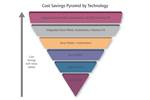
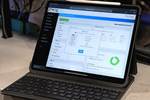




.png;maxWidth=300;quality=90)
















